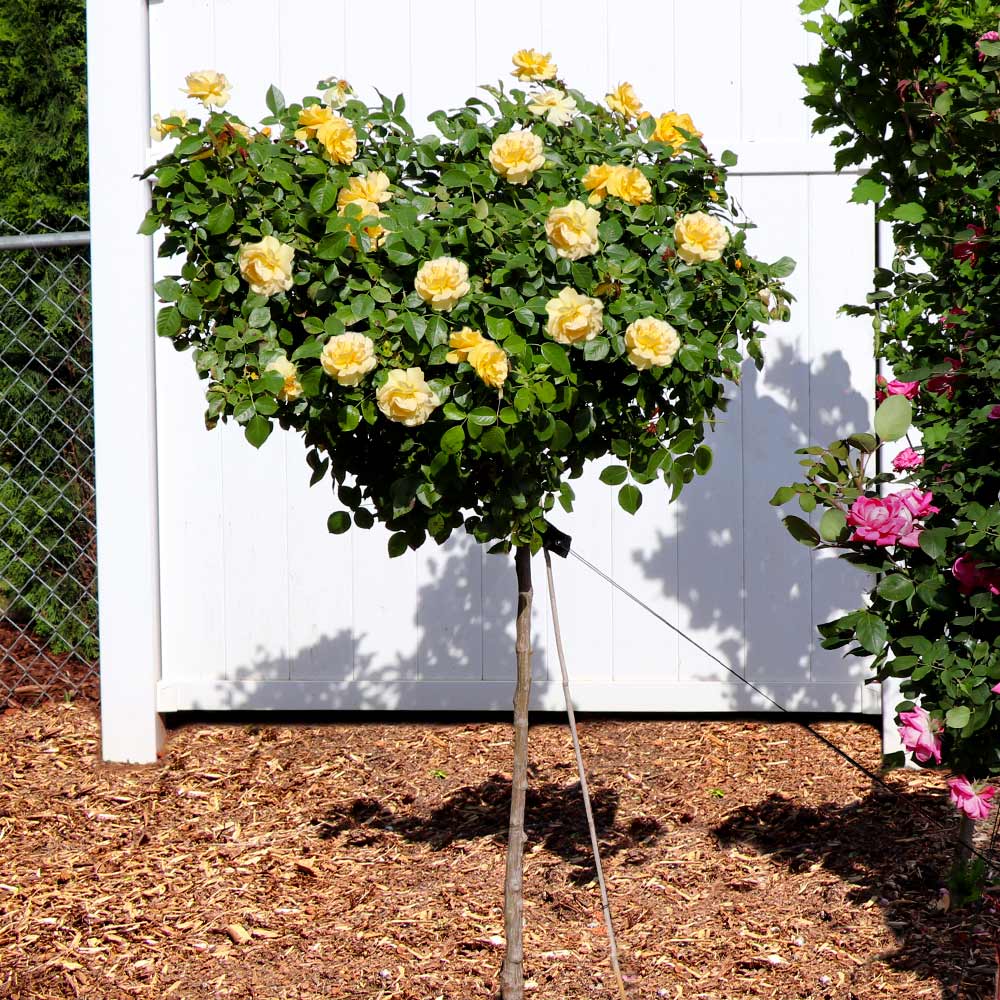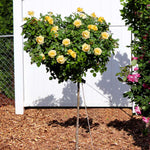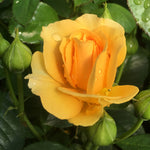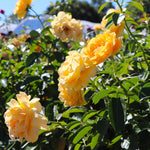Julia Child Standard Rose Tree Rosa 'Julia Child'




* Images shown are of mature plants
Julia Child Standard Rose Tree Rosa 'Julia Child'
Product Description
Award-Winning Standard Rose with Sunny Yellow Double Flowers
With a nod to the sunny personality of famed TV chef Julia Child, the rose that bears her name is equally cheerful. The Julia Child Standard Rose has twice the bloom power of single roses because each blossom is fully double! It's such an outstanding performer '– because of its re-blooming habit, disease resistance, and self-cleaning flowers '– that it was the 2006 All America Rose Selection Winner. You can grow this acclaimed rose right in your own garden, and we'll do you one better '– we're offering it as a tree-form rose!
Elegant Roses on a Dwarf Sized Tree
Tree-form roses are also called standard roses because of a unique manipulation. They're not really trees, but they resemble dwarf trees because of how they are grafted on tall stems, which look like slim tree trunks. All the foliage and flowers are held high above the ground at the top of a single stem for an intriguing look that you don't get from other types of roses. And you don't even have to bend down to cut fresh roses for your home '– they're nearly at eye level!
Clusters of Floribunda Flowers
The Julia Child Rose is classified as a floribunda rose. Unlike tea roses and other rose varieties, which bear a single flower at the tips of their stems, floribunda roses are formed in showy clusters of multiple flowers. One stem may bear six or more blossoms!
A Bountiful Rebloomer
Some roses "bloom out" after they've produced their flowers '– the show's over until the following year. Other roses go through bloom cycles with rest periods between flowering periods. But why grow these types of roses that are "here today and gone tomorrow" when you can grow the Julia Child Standard Rose, which blooms non-stop throughout the growing season?
Self-Cleaning Flowers
What we mean by "self-cleaning" is that you don't have to dead-head the flowers when they fade. This is uncommon in the world of roses. Usually, you have to snip off the old blossoms to keep a rose plant looking tidy. But Julia Child Standard Rose flowers drop their petals when they've finished blooming, leaving no unsightly spent flowers on the plant.
Armfuls of Fresh-Cut Flower Stems
One benefit of growing your own roses is that you don't have to buy expensive flowers for your fresh-cut floral arrangements. And when you cut a flowering stem from your Julia Child tree rose, you're assured of the freshness and keeping quality of its blossoms. When you bring home roses from the market or florist, the buds are so tight that often they don't even open '– what a disappointment! Cut your flowering stems just as the buds begin to open '– not when they're closed tightly and not when the flowers are fully opened. That way, they'll last much longer in a vase.
Floral design tip: Try placing Julia Child Roses in a cobalt-blue water-filled vase for a striking blue-and-yellow color combination!
Bred for Disease Resistance
Most roses are vulnerable to a host of diseases that mar their beauty and compromise their health. And just to keep these diseases at bay, you have to start spraying early in the season and continue a chemical spray regimen until a plant reaches its winter dormancy just to protect it from illness. It's so much easier to purchase disease-resistant plants, such as the Julia Child Standard Rose, that don't need this intensive care. You won't have to handle chemicals, spray them into your environment, and jeopardize the health of pollinators that visit your plants. It's simply an eco-friendly way to garden!
A Real Head-Turner
Julia Child Standard Rose is that focal point you want in your garden or flower bed. Even beautifully designed flower beds need tweaking or updating from time to time. With the addition of one Julia Child tree rose in an established bed, border, or island, you can instantly give your garden a new look ?… without changing anything else! You'll create a focal point by using your Julia Child Rose as a specimen plant that adds vertical interest plus masses of flowers.
Complementary Colors Enhance Each Other
You want the flower colors in your landscape design to blend with each other instead of clashing. With that in mind, choose flower colors that complement your yellow Julia Child roses. Shades of red and orange not only complement yellow, but working together, they form a color palette that enlivens landscapes with an electric touch. And if you really want to add zing to your landscape, take a tip from the University of Georgia: when you pair yellow flowers, such as Julia Child Roses, with purple flowers, each flower color really makes the other color pop!
The Perfect Mother's Day Gift!
Does your mom, best friend, or neighbor love gardening? Well, gardeners love getting plants as gifts! It's sometimes tough to know exactly what plant to choose for the gardeners on your list, but you will not disappoint if you give a Julia Child Standard Rose '– any gardener would love to have this fabulous plant. All you have to do is make sure that her garden has at least enough sun to plant this rose ?… or a sunny patio for a beautiful container!
Elegant and Formal Accents
You may already grow roses, but perhaps you haven't added a rose tree to your garden. Look no further, because Julia Child Standard Rose is a great choice to add to your rose collection! And if you have a formal courtyard garden, this plant makes a perfect centerpiece. One component of successful garden design is repeating common themes and colors throughout your landscape to tie everything together. So feel free to dot several Julia Child Roses along a sunny walkway to pull visitors through your garden.
Makes for a Great Container Plant!
Many gardeners prefer growing their prized plants in containers instead of in the ground. They find that the plants are easier to care for, and they can often be enjoyed closer to eye level when raised off the ground. One of the biggest benefits is that containers offer improved drainage, and this is an important consideration when your garden soil is compacted and you just don't want to get out a tiller and work the ground before planting something. If you don't enjoy weeding '– who does? '– you'll really love growing plants in containers, because they stay virtually weed-free!
Container potting tip: It's worth investing in a premium potting mix that's formulated specifically for potted plants. These professionally blended mixes are typically loose (for good drainage) and high in organic matter (to help nourish your plants).
Bid a Cheerful Welcome to Your Visitors
Plant Julia Child Standard Rose at or near your home's entrance, and your guests will love the sunny welcome! This entry garden is an area where most gardeners spend a lot of time to get the look "just right." After all, it's the calling card that expresses your personality and boosts your curb appeal. A single Julia Child Standard Rose tree is an awesome standalone plant near your front entrance, but several plants really bump up the wow factor. Plant in odd-number groupings, such as three plants to the left of your front stairs and three plants on the right, or plant two Julia Child rose trees '– one on either side of your walkway '– to form a floriferous gateway to your front door!
Very Easy to Prune
You won't have to spend an inordinate amount of time pruning your Julia Child Standard Rose, because we've done most of the work for you! You'll only have to make a few snips here and there to keep it shaped. In February, prune away any stems that are broken or dead, and any that cross over each other. You can cut the top growth back to 12 inches, and remove any suckers that sprout around the base of your plant. Even though your Julia Child Rose is self-cleaning '– the flower petals will fall on their own '– if you take hand pruners and snip the stems just below where the flowers bloomed, you'll prompt your plant to produce even more flowers!
Rose Care Tips
For the best health of your plant, our horticulturists recommend growing Julia Child Rose in full sun, planting it no deeper than it was in its original pot, keeping it watered well while making sure the soil drains well, and fertilizing it according to a soil test. If you didn't test your soil, apply 3 tablespoons of 12-4-8 or 16-4-8 around your plant each month from March through September.
Shipping Details
Estimated Shipping Time: Most orders ship within 1-2 days. As noted on the website, some items are seasonal, and may only ship in spring or fall. Once your order is shipped, you'll receive an email with a tracking number.
| Order Total | Shipping Charges |
|---|---|
| Less than $100 | $24.95 |
| $100.00-$128.99 | $29.95 |
| $129 + | FREE SHIPPING! |
Product Details
Growing Zones: 5-9 outdoors
 5-9 outdoors
(hardy down to -10℉)
5-9 outdoors
(hardy down to -10℉)
- Mature Height: 5 ft.
- Mature Width: 3 ft.
- Sunlight: Full Sun
- Spacing: 5 ft.
- Growth Rate: up to 2 ft.
- Does Not Ship To: AZ
Customer Reviews & Photos





